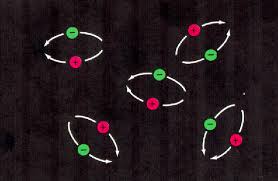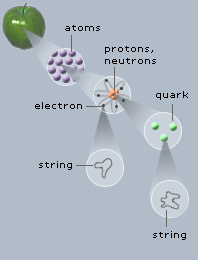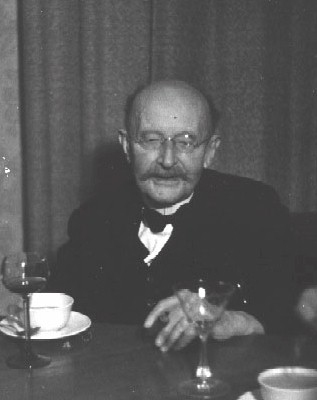Something From Nothing The Standard Big Bang Model, and String Theorys Resolution
Whenever someone talks about the Big Bang with someone who does not accept the scientific evidence for it, they often are told, Its not possible for an explosion of nothing to make something. After briefly laughing, or perhaps putting ones head in ones hands, somewhat distraught, as I have often done, I realize that the people making these statements are either avoiding the answer, or have simply not looked. For the first, it would be rather difficult to persuade them to look, and that their statement does have an answer. The problem I find with the answer given by the standard Big Bang Model is that the answer hardly makes sense, which will be explained briefly. Instead, the application of Superstring Theory allows us to present this answer in a way that allows us to avoid the inherent problems presented by the Standard Big Bang model.
Not An Explosion

This is not what the Big Bang was like.
As stated above, when someone mentions the Big Bang, we often hear the word Explosion thrown out there. The mistakes of calling the Big Bang an explosion are obvious to those who have at least some understanding of the theory, but to those who look for no evidence, or rely on Kent Hovind for answers (among other people), calling the Big Bang an explosion seems like a reasonable depiction. The problems with this analogy are as follows. First, an explosion implies matter. At the time when the Big Bang occurred, all four fundamental forces of the universe (the Electromagnetic force, Gravity, Strong Nuclear, and Weak Nuclear forces) were all amalgamated into one. The reason for this is because the temperature was trillions of Kelvin. Only when the temperature dropped could the forces separate. The process of separation is known as Spontaneous Symmetry Breaking. A good way to visualize this is by picturing the combined fundamental forces as water. When we lower the temperature the water freezes. This freezing is analogous to the separation of the fundamental forces. The reason for discussing this is because gravity, a fundamental force, would not have been able to pull apart virtual particle pairs yet because it was combined with the other three fundamental forces. The separation of the virtual particle pairs, and the effect upon them by the Nuclear forces are what leads to mass, and hence, matter.
What is a virtual particle pair? I will go into two explanations, a rough sketch of the idea, and a more precise one, as was explained to me by reading The Elegant Universe.
A Rough Sketch
A virtual particle pair is a pairing of a particle and its anti-particle. These virtual particle pairs appear out of thin air and mutually annihilate one another within Planck Time. Imagining how short Planck Time is is quite difficult, so I will just give you the number and hope you can use your imagination. One Planck Time is approximately equal to 5.391x10^-41 seconds long. This is extremely short. How then can we even tell virtual particles exist? We obviously never see them in a direct way. They are far too small and annihilate one another far too quickly to be seen. However, they do have an effect on their surroundings, and it is this way in which their existence is postulated and accepted.

Virtual particle pairs popping up and annihilating one another.
A More Precise Answer
From the rough sketch, we read that a virtual particle is a pairing of its particle and its anti-particle. An anti-particle is similar to its particle partner except in the fact that it has negative (and opposite of its partners) spin. For example, if a particle has spin-1/2, the anti-particle partner would have spin - 1/2. Spin is a tricky, and lengthy, thing to explain, especially in particle physics, because a zero-dimensional particle does not spin on an axis like something dimensional (a point does not have a center, because a point is its own center) and so I will not explain it here. The resulting collision between these pairs creates a burst of energy and often the release of a photon. Note that a photon has no mass, and is thus not matter (so we cant have that explosion.) What causes these virtual particle pairs to come into existence in the first place? Well, there is no reason for them to occur in one point of space over another. However, we do know what allows them to exist, and this is something known as quantum tunneling.
Somewhat analogous to borrowing money if you pay it all back in a certain amount of time, quantum tunneling allows a particle to borrow energy from the universe if it is repaid within a time that we can measure.

V0 represents the quantum tunneling action. Courtesy of stanford.edu
Basically, the borrowing of energy must be repaid before we can detect it. It may sound strange but the effects of quantum tunneling are very real. Particles can travel through walls if they do it in a short enough time. You could even walk through a wall, but every single particle in your body would have to quantum tunnel simultaneously, and so the likelihood of that happening is miniscule, to say the most (and thats an exaggeration!)
Back To It
Returning to the original paragraphs, we can see that an explosion requires matter, and matter did not exist when the Big Bang occurred. Second, an explosion happens within space, whereas the Big Bang encompassed the whole of space. What was the Big Bang then? An expansion of spacetime itself. What allowed it to expand? A powerful negative energy density that came about due to the fact that no matter existed within this infinitesimally small point (the point was something that troubled me, and will be addressed later.) Negative energy density can be observed and understood by learning about the Casimir Effect.
Understanding the Big Bang was not an explosion also nullifies the supposed point that Explosions always cause disorder and so the Big Bang makes disorder and so could not happen. The statement also implies ignorance regarding physical laws, and the fact that the Second Law can be violated via the Fluctuation Theorem.
The Problem With Granny Speck
The problem inherent when discussing the Big Bang models answer is brought about by our current understand of particle physics. Particles, being zero dimensional points, and also being regarded as the smallest, indivisible constituents of anything, have zero volume. When we rewind the universe, the Standard Big Bang model predicts that the universe was once a zero dimensional point. There are several problems here. First of all, we live in four dimensional spacetime. What happened to our three space dimensions? If a point is infinitesimally small, the space dimensions could not simply have curled up and shrunk they would have had to disappear entirely. The second problem regards virtual particle pairs and Paulis Exclusion Principle.
Say what?
Paulis Exclusion Principle sounds scary at first, but understanding it is not hard to grasp. It states simply that two fermions (matter particles like quarks and electrons) cannot share quantum states. To give some insight as to what this means, we will turn over to something called Heisenbergs Uncertainty Principle. Heisenberg found out that it is impossible to know the exact location and momentum of something at a given time. Also, the more precise a measurement of momentum, the less precise the measurement of location is, and vice versa. This is because to measure something, it must be done against some sort of medium. To see the particles, we must shoot some particle at it. For example, to see the path of an electron exactly, we would have to bounce photons off of it, and that would cause a disturbance, throwing off our results. We cannot know exactly. How does this tie in? Well, if our fermions existed in a zero-dimensional point, we would know their exact location and momentum because they couldnt move anywhere. This violates Paulis Exclusion Principle, because two things would exist in the same quantum state of energy, and would make Heisenberg a bit worried.

Notice how the two electrons have different charges, so they dont violate the Exclusion Principle.
It is not possible to squeeze everything into a zero-dimensional point. The equations physicists get from trying to do it result in nonsense. This of course has to do with the problems combining quantum mechanics and general relativity, but I will put off that discussion for another time. It is already obvious that particle physics has presented us with a large problem when it comes to the Big Bang and the singularity postulated by It when we rewind the clock.
Whenever someone talks about the Big Bang with someone who does not accept the scientific evidence for it, they often are told, Its not possible for an explosion of nothing to make something. After briefly laughing, or perhaps putting ones head in ones hands, somewhat distraught, as I have often done, I realize that the people making these statements are either avoiding the answer, or have simply not looked. For the first, it would be rather difficult to persuade them to look, and that their statement does have an answer. The problem I find with the answer given by the standard Big Bang Model is that the answer hardly makes sense, which will be explained briefly. Instead, the application of Superstring Theory allows us to present this answer in a way that allows us to avoid the inherent problems presented by the Standard Big Bang model.
Not An Explosion

This is not what the Big Bang was like.
As stated above, when someone mentions the Big Bang, we often hear the word Explosion thrown out there. The mistakes of calling the Big Bang an explosion are obvious to those who have at least some understanding of the theory, but to those who look for no evidence, or rely on Kent Hovind for answers (among other people), calling the Big Bang an explosion seems like a reasonable depiction. The problems with this analogy are as follows. First, an explosion implies matter. At the time when the Big Bang occurred, all four fundamental forces of the universe (the Electromagnetic force, Gravity, Strong Nuclear, and Weak Nuclear forces) were all amalgamated into one. The reason for this is because the temperature was trillions of Kelvin. Only when the temperature dropped could the forces separate. The process of separation is known as Spontaneous Symmetry Breaking. A good way to visualize this is by picturing the combined fundamental forces as water. When we lower the temperature the water freezes. This freezing is analogous to the separation of the fundamental forces. The reason for discussing this is because gravity, a fundamental force, would not have been able to pull apart virtual particle pairs yet because it was combined with the other three fundamental forces. The separation of the virtual particle pairs, and the effect upon them by the Nuclear forces are what leads to mass, and hence, matter.
What is a virtual particle pair? I will go into two explanations, a rough sketch of the idea, and a more precise one, as was explained to me by reading The Elegant Universe.
A Rough Sketch
A virtual particle pair is a pairing of a particle and its anti-particle. These virtual particle pairs appear out of thin air and mutually annihilate one another within Planck Time. Imagining how short Planck Time is is quite difficult, so I will just give you the number and hope you can use your imagination. One Planck Time is approximately equal to 5.391x10^-41 seconds long. This is extremely short. How then can we even tell virtual particles exist? We obviously never see them in a direct way. They are far too small and annihilate one another far too quickly to be seen. However, they do have an effect on their surroundings, and it is this way in which their existence is postulated and accepted.

Virtual particle pairs popping up and annihilating one another.
A More Precise Answer
From the rough sketch, we read that a virtual particle is a pairing of its particle and its anti-particle. An anti-particle is similar to its particle partner except in the fact that it has negative (and opposite of its partners) spin. For example, if a particle has spin-1/2, the anti-particle partner would have spin - 1/2. Spin is a tricky, and lengthy, thing to explain, especially in particle physics, because a zero-dimensional particle does not spin on an axis like something dimensional (a point does not have a center, because a point is its own center) and so I will not explain it here. The resulting collision between these pairs creates a burst of energy and often the release of a photon. Note that a photon has no mass, and is thus not matter (so we cant have that explosion.) What causes these virtual particle pairs to come into existence in the first place? Well, there is no reason for them to occur in one point of space over another. However, we do know what allows them to exist, and this is something known as quantum tunneling.
Somewhat analogous to borrowing money if you pay it all back in a certain amount of time, quantum tunneling allows a particle to borrow energy from the universe if it is repaid within a time that we can measure.

V0 represents the quantum tunneling action. Courtesy of stanford.edu
Basically, the borrowing of energy must be repaid before we can detect it. It may sound strange but the effects of quantum tunneling are very real. Particles can travel through walls if they do it in a short enough time. You could even walk through a wall, but every single particle in your body would have to quantum tunnel simultaneously, and so the likelihood of that happening is miniscule, to say the most (and thats an exaggeration!)
Back To It
Returning to the original paragraphs, we can see that an explosion requires matter, and matter did not exist when the Big Bang occurred. Second, an explosion happens within space, whereas the Big Bang encompassed the whole of space. What was the Big Bang then? An expansion of spacetime itself. What allowed it to expand? A powerful negative energy density that came about due to the fact that no matter existed within this infinitesimally small point (the point was something that troubled me, and will be addressed later.) Negative energy density can be observed and understood by learning about the Casimir Effect.
Understanding the Big Bang was not an explosion also nullifies the supposed point that Explosions always cause disorder and so the Big Bang makes disorder and so could not happen. The statement also implies ignorance regarding physical laws, and the fact that the Second Law can be violated via the Fluctuation Theorem.
The Problem With Granny Speck
The problem inherent when discussing the Big Bang models answer is brought about by our current understand of particle physics. Particles, being zero dimensional points, and also being regarded as the smallest, indivisible constituents of anything, have zero volume. When we rewind the universe, the Standard Big Bang model predicts that the universe was once a zero dimensional point. There are several problems here. First of all, we live in four dimensional spacetime. What happened to our three space dimensions? If a point is infinitesimally small, the space dimensions could not simply have curled up and shrunk they would have had to disappear entirely. The second problem regards virtual particle pairs and Paulis Exclusion Principle.
Say what?
Paulis Exclusion Principle sounds scary at first, but understanding it is not hard to grasp. It states simply that two fermions (matter particles like quarks and electrons) cannot share quantum states. To give some insight as to what this means, we will turn over to something called Heisenbergs Uncertainty Principle. Heisenberg found out that it is impossible to know the exact location and momentum of something at a given time. Also, the more precise a measurement of momentum, the less precise the measurement of location is, and vice versa. This is because to measure something, it must be done against some sort of medium. To see the particles, we must shoot some particle at it. For example, to see the path of an electron exactly, we would have to bounce photons off of it, and that would cause a disturbance, throwing off our results. We cannot know exactly. How does this tie in? Well, if our fermions existed in a zero-dimensional point, we would know their exact location and momentum because they couldnt move anywhere. This violates Paulis Exclusion Principle, because two things would exist in the same quantum state of energy, and would make Heisenberg a bit worried.

Notice how the two electrons have different charges, so they dont violate the Exclusion Principle.
It is not possible to squeeze everything into a zero-dimensional point. The equations physicists get from trying to do it result in nonsense. This of course has to do with the problems combining quantum mechanics and general relativity, but I will put off that discussion for another time. It is already obvious that particle physics has presented us with a large problem when it comes to the Big Bang and the singularity postulated by It when we rewind the clock.




